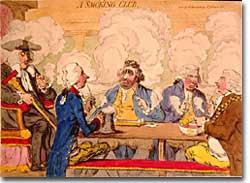 |
| Rows of different varieties of tobacco in Lancaster County, PA. |
 |
| Lancaster County Amish farm. Click on the image and you will be able to see clothing strung on a wash line to the right of the farm house on the right of the photo. |
 |
| Native and Colonial Americans celebrate an event by sharing tobacco in this early etching. |
When the Europeans arrived in North America the Native Americans introduced their visitors to tobacco, since smoking was an integral part of Indian healing and religious ceremonies. It seems it was also part of treaty signings and conferences shortly after the Europeans arrived. The new colonists began to raise their own tobacco so they too could look neat smoking a "stogie", which by the way got it's name in Lancaster. Seems the wagon masters on the Conestoga Wagons would smoke long cigars using coarser leaves that gave off a strong aroma which became known as a "stogie".
 |
| Among 18th-century Europeans, tobacco smoking indicated a high social class. In this 1793 etching by James Gillray, wealthy men are seen indulging in tobacco at what was known as a "smoking club". |

No comments:
Post a Comment